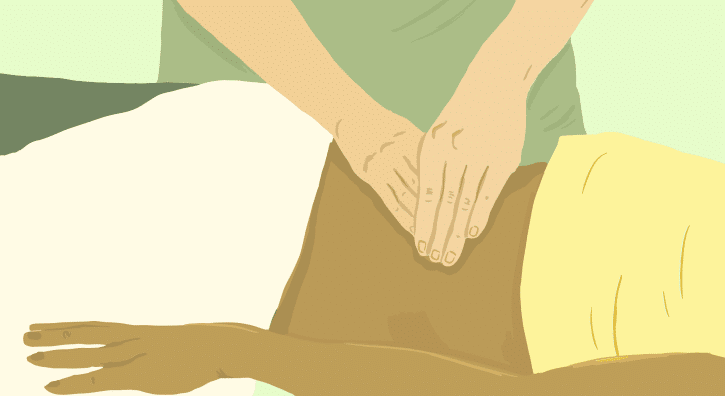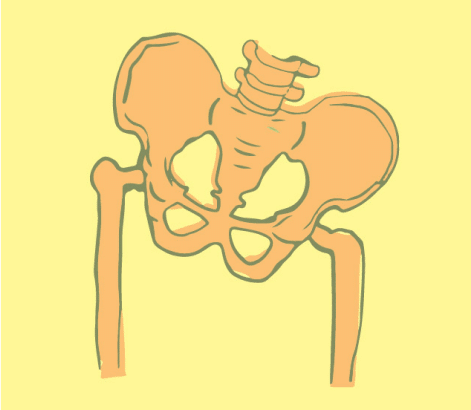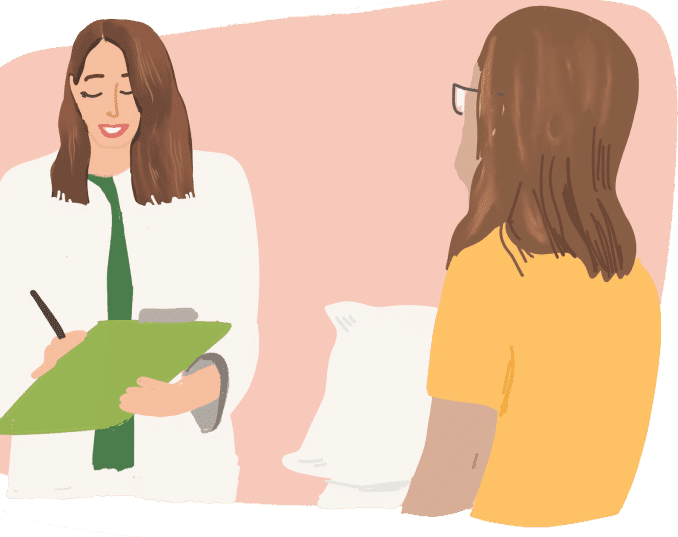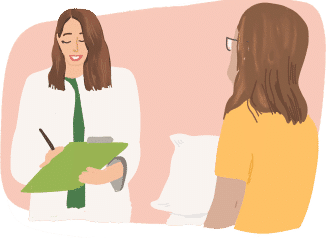

Experiencing ongoing issues with intimacy—such as low sexual desire, trouble maintaining arousal, painful sensations, or difficulties achieving orgasm—may indicate sexual dysfunction. A key factor that’s often missed in these cases is the condition of the pelvic floor muscles. These muscles are integral to sexual performance: they help sustain erections in men and are responsible for the rapid, pleasurable contractions that occur during orgasm in both genders. When functioning properly, the pelvic floor enhances the enjoyment of intimacy. However, when muscle dysfunction occurs—whether due to tension, weakness, or coordination problems—it can lead to painful or unsatisfying experiences. This emotional and physical disruption can be distressing, but pelvic floor physical and occupational therapy offers a highly effective route to recovery by restoring the muscle balance necessary for healthy sexual function.
The Facts
- About 33% of premenopausal women experience some level of sexual pain during their reproductive years.
- Reports of erectile challenges among men under 40 range widely, from 15% to 72%, depending on individual health and emotional factors.
- Erectile dysfunction affects more than half of men aged between 40 and 70, often presenting as mild to moderate impairment.
- After prostate surgery, nearly 80% of men experience difficulty with sexual performance, particularly achieving or maintaining erections.
- Six out of ten menopausal women feel too self-conscious to bring up painful sex during consultations with their physicians.
- Birth control pills and acne medications can sometimes cause unwanted side effects like vulvar discomfort and reduced lubrication, making intercourse uncomfortable.
- Long after childbirth, 65% of women report that sex remains painful—sometimes lasting up to 18 months postpartum.
Experiencing ongoing issues with intimacy—such as low sexual desire, trouble maintaining arousal, painful sensations, or difficulties achieving orgasm—may indicate sexual dysfunction. A key factor that’s often missed in these cases is the condition of the pelvic floor muscles. These muscles are integral to sexual performance: they help sustain erections in men and are responsible for the rapid, pleasurable contractions that occur during orgasm in both genders. When functioning properly, the pelvic floor enhances the enjoyment of intimacy. However, when muscle dysfunction occurs—whether due to tension, weakness, or coordination problems—it can lead to painful or unsatisfying experiences. This emotional and physical disruption can be distressing, but pelvic floor physical and occupational therapy offers a highly effective route to recovery by restoring the muscle balance necessary for healthy sexual function.
The Facts
- About 33% of premenopausal women experience some level of sexual pain during their reproductive years.
- Reports of erectile challenges among men under 40 range widely, from 15% to 72%, depending on individual health and emotional factors.
- Erectile dysfunction affects more than half of men aged between 40 and 70, often presenting as mild to moderate impairment.
- After prostate surgery, nearly 80% of men experience difficulty with sexual performance, particularly achieving or maintaining erections.
- Six out of ten menopausal women feel too self-conscious to bring up painful sex during consultations with their physicians.
- Birth control pills and acne medications can sometimes cause unwanted side effects like vulvar discomfort and reduced lubrication, making intercourse uncomfortable.
- Long after childbirth, 65% of women report that sex remains painful—sometimes lasting up to 18 months postpartum.
Symptoms
*Sexual Dysfunction in people with a penis
- Erectile challenges can take many forms, such as softer erections, difficulty sustaining them, or orgasms occurring too rapidly.
- For some, the force of ejaculation becomes notably weaker, or may seem to disappear altogether.
- Experiencing leakage of urine at the moment of climax—medically termed climacturia—is another possible symptom.
- Pain that follows ejaculation may radiate from the tip of the penis, along the shaft, into the scrotum, or in the perineal area.
- Abnormal skin coloration around the genital or perineal areas may accompany physical discomfort or dysfunction.
Postpartum Sexual Dysfunction
- Hormone fluctuations during breastfeeding often lead to lubrication difficulties and dryness
- Pain or soreness around the perineum, typically caused by tearing or surgical intervention during delivery
- Challenges in reaching orgasm or noticeable decline in sexual pleasure post-birth
- Urine leakage that may unexpectedly happen during sex or climax
- Ongoing pain during sex, which may persist long after the postpartum period begins
*Sexual Dysfunction in people with vulvas/vaginas
- Difficulty maintaining natural vaginal lubrication, causing dryness that interferes with sexual enjoyment
- Pain that presents during the start of penetration, with thrusting, or remains persistent throughout sex
- Sensitivity of the clitoral region that leads to unpleasant or painful reactions to touch
- A burning or raw sensation experienced in the vulvar or vaginal area after intercourse
- Inability to achieve orgasm, or noticing a marked decline in the strength of orgasmic response
- Accidental urination during sex, sometimes occurring without warning or control
- Orgasm-triggered involuntary urination (climacturia), which may indicate pelvic floor dysfunction
Menopausal Sexual Dysfunction and Post-gynecologic cancer treatment
- Lack of lubrication caused by a drop in estrogen, affecting vaginal comfort
- Struggles with or intolerance of vaginal penetration due to tissue fragility
- Pain that arises during sex and may remain present well after intercourse ends
- Reduced orgasmic sensation or an inability to climax altogether
Symptoms
*Sexual Dysfunction in people with a penis
- Erectile challenges can take many forms, such as softer erections, difficulty sustaining them, or orgasms occurring too rapidly.
- For some, the force of ejaculation becomes notably weaker, or may seem to disappear altogether.
- Experiencing leakage of urine at the moment of climax—medically termed climacturia—is another possible symptom.
- Pain that follows ejaculation may radiate from the tip of the penis, along the shaft, into the scrotum, or in the perineal area.
- Abnormal skin coloration around the genital or perineal areas may accompany physical discomfort or dysfunction.
*Sexual Dysfunction in people with vulvas/vaginas
- Difficulty maintaining natural vaginal lubrication, causing dryness that interferes with sexual enjoyment
- Pain that presents during the start of penetration, with thrusting, or remains persistent throughout sex
- Sensitivity of the clitoral region that leads to unpleasant or painful reactions to touch
- A burning or raw sensation experienced in the vulvar or vaginal area after intercourse
- Inability to achieve orgasm, or noticing a marked decline in the strength of orgasmic response
- Accidental urination during sex, sometimes occurring without warning or control
- Orgasm-triggered involuntary urination (climacturia), which may indicate pelvic floor dysfunction
Postpartum Sexual Dysfunction
- Hormone fluctuations during breastfeeding often lead to lubrication difficulties and dryness
- Pain or soreness around the perineum, typically caused by tearing or surgical intervention during delivery
- Challenges in reaching orgasm or noticeable decline in sexual pleasure post-birth
- Urine leakage that may unexpectedly happen during sex or climax
- Ongoing pain during sex, which may persist long after the postpartum period begins
Menopausal Sexual Dysfunction and Post-gynecologic cancer treatment
- Lack of lubrication caused by a drop in estrogen, affecting vaginal comfort
- Struggles with or intolerance of vaginal penetration due to tissue fragility
- Pain that arises during sex and may remain present well after intercourse ends
- Reduced orgasmic sensation or an inability to climax altogether
Associated Diagnoses
Diagnoses such as Endometriosis, Vulvodynia, Interstitial Cystitis/Painful Bladder Syndrome, Pudendal Neuralgia, Chronic Pelvic Pain Syndrome/Male Pelvic Pain, Lichen Sclerosus, Lichen Planus, Pelvic Floor Dysfunction, post-prostatectomy complications, and Genitourinary Syndrome of Menopause are all associated with sexual dysfunction and pelvic pain.

Associated Diagnoses
Diagnoses such as Endometriosis, Vulvodynia, Interstitial Cystitis/Painful Bladder Syndrome, Pudendal Neuralgia, Chronic Pelvic Pain Syndrome/Male Pelvic Pain, Lichen Sclerosus, Lichen Planus, Pelvic Floor Dysfunction, post-prostatectomy complications, and Genitourinary Syndrome of Menopause are all associated with sexual dysfunction and pelvic pain.


Causes of Sexual Dysfunction
- Pelvic pain syndromes associated with pelvic floor dysfunction (above)
- Childbirth
- Medications
- Obesity
- Cardiovascular disease
- Menopause
- Jelqing
- Genital mutilation, genital cutting
- Surgically-induced
- Pelvic Floor Reconstruction
- Prostatectomy
- Gender affirming surgery
- Episiotomy
- Vestibulectomy
- Pudendal Nerve Decompression
- Mesh excision
Causes of Sexual Dysfunction
- Pelvic pain syndromes associated with pelvic floor dysfunction (above)
- Childbirth
- Medications
- Obesity
- Cardiovascular disease
- Menopause
- Jelqing
- Genital mutilation, genital cutting
- Surgically-induced
- Pelvic Floor Reconstruction
- Prostatectomy
- Gender affirming surgery
- Episiotomy
- Vestibulectomy
- Pudendal Nerve Decompression
- Mesh excision

Diagnostic Challenges
Conversations about sexual health continue to be a challenge in healthcare settings. Many physicians still struggle to approach the topic with ease, while patients often carry the weight of shame or fear of being dismissed. This lack of communication is particularly damaging for LGBTQ+ individuals, who are frequently underserved or misunderstood by the very systems meant to support them. At PHRC, we’ve made it our mission to shift that paradigm. We create space for honest, judgment-free dialogue and individualized care plans that reflect each patient’s unique experience. Sexual health is no longer viewed as a fringe topic—it’s now a respected medical field, requiring holistic treatment approaches that encompass physical, psychological, and relational health. By integrating pelvic floor therapy with mental health support and medical evaluation, we help our patients move toward a healthier, more satisfying experience of intimacy and self.
Diagnostic Challenges
Conversations about sexual health continue to be a challenge in healthcare settings. Many physicians still struggle to approach the topic with ease, while patients often carry the weight of shame or fear of being dismissed. This lack of communication is particularly damaging for LGBTQ+ individuals, who are frequently underserved or misunderstood by the very systems meant to support them. At PHRC, we’ve made it our mission to shift that paradigm. We create space for honest, judgment-free dialogue and individualized care plans that reflect each patient’s unique experience. Sexual health is no longer viewed as a fringe topic—it’s now a respected medical field, requiring holistic treatment approaches that encompass physical, psychological, and relational health. By integrating pelvic floor therapy with mental health support and medical evaluation, we help our patients move toward a healthier, more satisfying experience of intimacy and self.
Treatment:
How We Can Help You

Living in Agoura Hills and facing challenges with sexual function can be overwhelming, but pelvic floor physical and occupational therapy may be the missing piece in your recovery journey. We recommend scheduling an evaluation with our experienced team to determine if pelvic floor issues are contributing to your symptoms. Your first appointment begins with an open, detailed conversation about your medical background, past treatments, and any diagnoses you’ve received. For many clients in Agoura Hills, this is the first time they feel truly heard. Our exam includes a hands-on assessment of your pelvic floor muscles, surrounding tissues, nerves, and movement mechanics to uncover dysfunction that might be impacting intimacy or comfort. After reviewing all findings, your therapist will craft a personalized treatment plan that addresses both immediate concerns and longer-term goals. Most individuals benefit from one to two weekly sessions over a 12-week span, supported by tailored exercises to continue at home. To ensure continuity and effectiveness, we also collaborate with any other medical professionals involved in your care. Our role is to be your ally on the path to healing, so you can reclaim a life of comfort and confidence in Agoura Hills and beyond.

Treatment:
How We Can Help You
Living in Agoura Hills and facing challenges with sexual function can be overwhelming, but pelvic floor physical and occupational therapy may be the missing piece in your recovery journey. We recommend scheduling an evaluation with our experienced team to determine if pelvic floor issues are contributing to your symptoms. Your first appointment begins with an open, detailed conversation about your medical background, past treatments, and any diagnoses you’ve received. For many clients in Agoura Hills, this is the first time they feel truly heard. Our exam includes a hands-on assessment of your pelvic floor muscles, surrounding tissues, nerves, and movement mechanics to uncover dysfunction that might be impacting intimacy or comfort. After reviewing all findings, your therapist will craft a personalized treatment plan that addresses both immediate concerns and longer-term goals. Most individuals benefit from one to two weekly sessions over a 12-week span, supported by tailored exercises to continue at home. To ensure continuity and effectiveness, we also collaborate with any other medical professionals involved in your care. Our role is to be your ally on the path to healing, so you can reclaim a life of comfort and confidence in Agoura Hills and beyond.
How Can We Help You?
Please use the form below to send us any questions or comments. You must include your e-mail address in order for us to send a response. Please be assured that all of your information will be kept confidential.

Join The Newsletter. Win a copy of our book, “Pelvic Pain Explained!”
We love getting to know our website visitors. Please tell us a little bit about yourself and get the latest info via PHRC e-newsletter!
*Subscribers automatically eligible to win our book, “Pelvic Pain Explained.”
Pelvic Pain Explained presents a comprehensive and deeply human account of what it means to live with chronic pelvic pain. It is a story of complexity, beginning with the elusive nature of symptoms and the long road many travel to receive a proper diagnosis. The book lays bare the systemic gaps in care, the hesitations and missteps from healthcare providers, and the emotional strain that such a prolonged journey places on patients. It thoughtfully considers the overwhelming number of treatment options available—many of which bring more questions than answers—and emphasizes the confusion this creates for those in pain. Perhaps most importantly, it explores the unseen consequences of pelvic pain, the way it quietly infiltrates relationships, intimacy, and the very sense of self.


